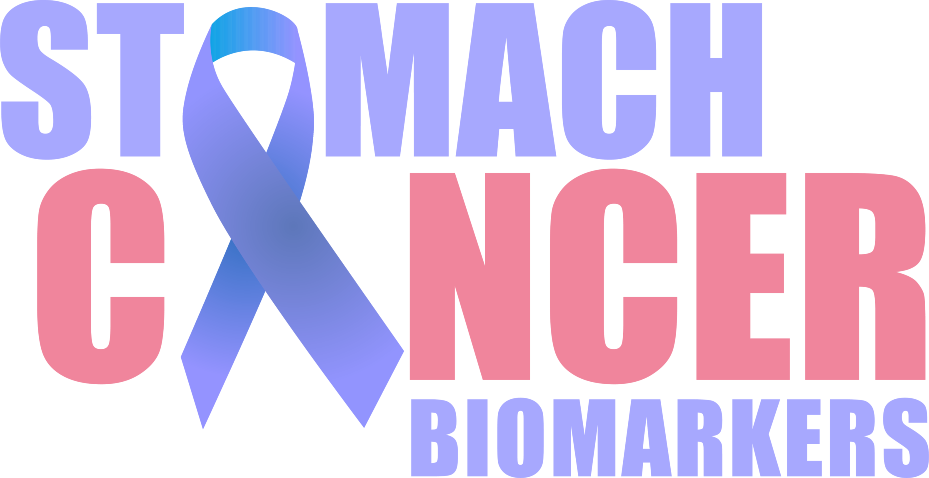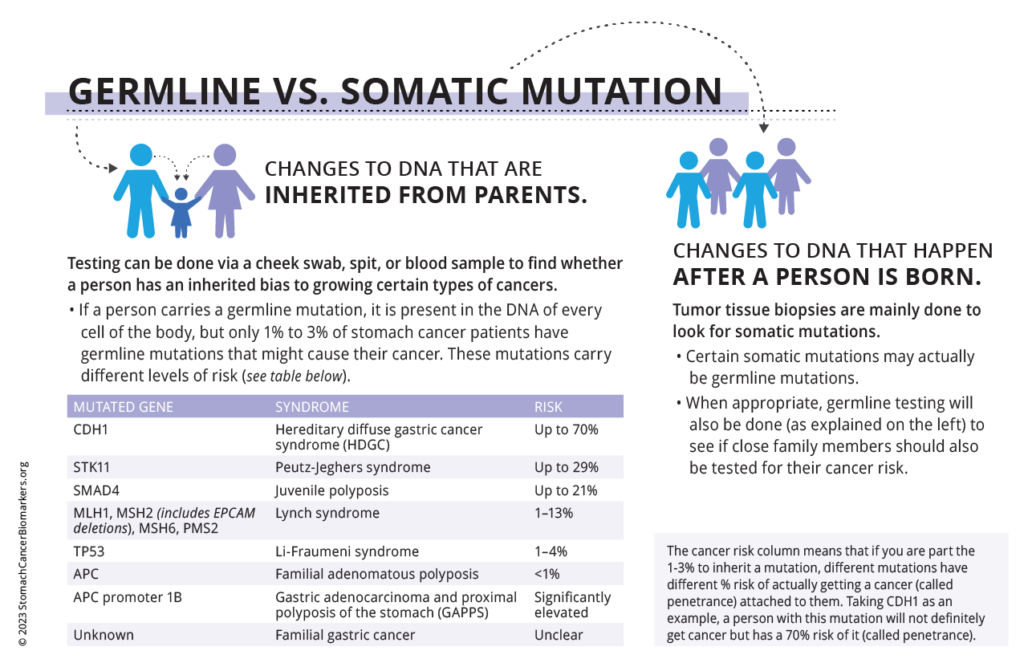Germanline Vs. Somatic Mutation
Germline Mutations
Germline mutations are DNA changes a person inherits from their parents and are in them from birth. Somatic mutations are changes to DNA that happen after a person is born.
Germline mutations are present in every cell of the body. Germline genetic testing can be done via a cheek swab, spit, or blood sample.
Germline Mutation Testing
Cancer germline testing looks at whether a person has an inherited bias toward growing certain types of cancers.
Only 1% to 3% of stomach cancer patients are thought to have a hereditary form of the cancer. The following gene mutations can be inherited. The cancer risk column means that if you are in the unlucky 1-3% to inherit a mutation, different mutations have different % risk of actually getting a cancer (called penetrance) attached to them. Taking CDH1 as an example, a person with this mutation will not definitely get cancer but has a 70% risk of it.
Genetic risk-associated gene mutations in Gastric cancer:
Mutated Gene | Syndrome | Gastric Cancer Risk |
|---|---|---|
CDH1 | Hereditary diffuse gastric cancer syndrome (HDGC) | Up to 70% |
STK11 | Peutz-Jeghers syndrome | Up to 29% |
SMAD4 | Juvenile polyposis | Up to 21% |
MLH1, MSH2 (includes EPCAM deletions), MSH6, PMS2 | Lynch syndrom | 1-13% |
TP53 | Li-Fraumeni syndrome | 1-4% |
APC | Familial adenomatous polyposis | <1% |
APC promoter 1B | Gastric adenocarcinoma and proximal polyposis of the stomach (GAPPS) | Significantly elevated |
Unknown | Familial gastric cancer | unclear |
Somatic Mutations
When we take a tumor tissue biopsy to test for cancer mutations, we look mainly for somatic mutations. If a somatic mutation is present that can also be a germline mutation; when appropriate, germline testing (of your normal cell DNA) will also be done to make sure that close family members are not also at risk.
Somatic Mutation Testing
Once taken, a tissue biopsy is sent to a lab for extraction and analysis of its DNA.
DNA contains the code to make proteins. Humans have developed tools to read this code. These tools allow us to see mutations (changes or mistakes) in the DNA that cause and have grown in cancer. They help us see if the DNA mutations whose coded proteins act as targets for specially-made treatments are present in cancer tissue.
We read DNA using a process called DNA sequencing. In this method, thesequence (string) of DNA is broken into small pieces (the individual building blocks of DNA called bases A, T, C and G), which are read very carefully. The specific A,T,C,G sequence or code of the gene provides the whole gene’s sequence. Abnormalities in the cancer DNA gene’s sequence can be identified when compared to a gene’s normal DNA sequence.
Next Generation Sequencing (NGS) is a phrase used to describe a range of tools that speed up DNA sequencing to evaluate many different genes simultaneously.
Large commercial companies such as Caris, Tempus, and Foundation Medicine carry out NGS, as do larger Academic Centers.
Liquid Biopsies
A liquid biopsy is a sample of blood, usually drawn from a person’s arm. The use of liquid biopsies is attractive because blood sampling is a much more non-invasive way of entering into the living body than a tumor biopsy or surgery. Collecting blood is relatively easy, meaning sampling multiple times throughout a person’s disease course is possible, allowing real-time study.
Liquid biopsies can be used in the localized or locally advanced settings in order to see if the cancer is still there after curative surgical treatment by evaluating whether cancer (tumor) DNA is present in a person’s blood despite having undergone surgery. However, liquid biopsies for guiding treatment after surgery are still mostly under study. A company called Natera invites us to “Know Cancer’s Next Move” by using their liquid biopsy test (called Signatera) that measures circulating tumor DNA (ctDNA) with high sensitivity that can potentially help guide the best treatment moving forward. This test requires tissue NGS testing in addition to blood ctDNA testing.
The “Guardant360 CDx” test uses a blood sample to perform NGS to detect 73 different cancer genes for abnormalities simultaneously. This test, and others like it, are applicable in the metastatic (stage IV) or locally advanced unresectable settings. The aim with ctDNA testing in this stage IV setting is generally to see if a person might benefit from treatment with targeted therapies, as is done with tumor biopsies, but it can also be used to follow and monitor the status of the cancer over time in terms of how it is responding to a given therapy. The “Guardant360 CDx” test has been FDA-approved for any solid tumor cancer, including stomach cancer, in this setting.

